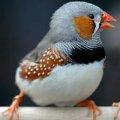An international team of researchers has sequenced the genome of the zebra finch. Their work reveals a lot about songbird genetics, and opens a new door to understanding the basis of human speech.
The Australian zebra finch is named for the black and white stripes on the male's throat — he's the one who does all the singing. The zebra finch survives well in captivity. That makes it both a popular pet and a favorite subject for researchers.
Model of Understanding University of California-San Francisco psychiatrist and neuroscientist Allison Doupe got interested in finches because they provide a model for understanding how people learn to speak. Doupe says that like human infants, songbirds have to hear adults during a critical period early in life. "Then they have to practice — their first vocalizations are like babbling in babies, and they have to hear themselves while they practice." Their songs gradually get better and better, like children learning to speak. "So it turns out that lots of the behavior is fairly similar between speech learning and songbird learning." Songbirds are one of the few groups of animals that — like humans — are capable of vocal learning. Others include whales, elephants, and bats. Researchers have been studying the zebra finch to try to identify the genes that make this vocal learning possible.
Turning on genes Neurobiologist David Clayton from the University of Illinois at Urbana-Champaign is one of the lead researchers in an international team that has sequenced and analyzed the genome of the zebra finch. "When a bird hears another bird singing or sings himself, this seems to engage a very large number of genes in the brain. Genes are being turned off, genes are being turned on." A previous study by Clayton's lab had shown that, as a young finch first learns how to sing, hundreds of genes in its brain quickly respond, producing more or less protein. Now, with a map of the whole genome in hand, the researchers looked at how individual genes in the adult finch brain respond to singing.
"We found a surprisingly large number of genes are being regulated," says Clayton. In fact, they found that at least 800 genes spring into action in a finch's brain whenever it sings. Not only that, but most of those genes are of a kind that scientists used to think of as molecular junk. Instead of producing proteins, the genes produce something called non-coding RNA.
"That non-coding RNA, well, what does it do? Well, it's not that it's going to make a protein," explains Clayton. "It's going to turn around and bind to other RNAs, physically bind to them, in a way that will then determine whether those other RNAs get made into protein or not." Similar to humans Wes Warren is the assistant director of the Genome Center at Washington University in St. Louis, and a leader of the finch genome sequencing project. He says that the same kinds of complex genetic interactions that are happening in the songbird brain are probably happening in ours.
"As you're hearing my words as I'm speaking, your brain is processing those words, and we think analogous to what's going on in the bird, there's genes in particular areas of your brain, that are being expressed very rapidly or decreased very rapidly to allow you to process that information." Since we've heard those words before, Warren says our brain has formed a kind of "molecular memory" of them. "And your ability to decipher them and understand them and reproduce them is a response to all these genes that are being regulated in your brain." Clues to human speech disorders Warren says now that researchers have a map of the zebra finch genome, they can carry out experiments to identify which genes in the finch's brain are most critical to hearing and producing song — and by extension, which genes may play a role in human speech disorders, like those related to stuttering, autism, and Parkinson's disease. Researchers will also be able to learn more about songbird evolution.
"The songbird community as a whole I think is very excited about this," says Allison Doupe. She wasn't involved in the finch genome research but she's been looking forward to its completion. "It's really the beginning of the next age of studies of songbirds, where we're going to have lots of additional tools." The zebra finch genome analysis is published in the latest issue of the journal Nature.

